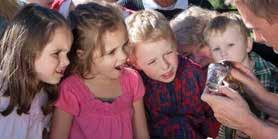
4 minute read
The beloved, yet forgotton, wildlife victim
The beloved, yet forgotten, wildlife victim of our bushfires
WORDS CATHARINE RETTER
Advertisement

There’s been a stoically silent victim of the devasting bushfires and drought in eastern Australia. It’s cute and (looks) cuddly, but its shy and elusive nature means it doesn’t get the worldwide publicity that our beloved koalas do. It’s the iconic Australian platypus, that uniquely different egg-laying, webfooted, fur-covered, duck-billed monotreme that is found nowhere else in the world but here.
We may think river-dwelling creatures are the lucky ones during a bushfire but when the fires swept through our national parks and forests and pasturelands, the platypus’s habitat was already severely affected by the drought’s falling river levels — exacerbated by its human neighbours who had been driven to pumping water from rivers and creeks, legally and illegally.
Another fascinating fact about these unique creatures is that, on land, they can retract the webbing between their claws. Unfortunately, they are also at their most vulnerable to foxes and feral cats and dogs when they are forced to cross land to seek new watery habitats.
Once the platypus’s habitat of healthy rivers and creeks disappears, so too does the platypus in the wild … from our entire planet.
It’s difficult to estimate numbers because the platypus is a shy, mainly nocturnal creature, and its last line of defence is to retreat deep into its burrow. But, by scientists and wildlife rescuers going to known habitats, platypus absences tell the story, as do the GREAT OUTDOORS • The Australian Platypus
presence of weakened and stranded animals. Sadly, that story over the past decade includes no sign of habitation in 41 percent of their previous range in eastern Australia.
Organisations caring for bushfire affected areas — including Aussie Ark and Australian Reptile Park staff — who visited known platypus areas have come back with the heart-breaking assessment that thousands, if not tens of thousands of platypuses will have been killed in recent months.
Scientists also believe the advent of heavy rains brings further habitat destruction as charred debris, ash, and sooty topsoil flow into the river systems and affect the water quality.

Wildlife rescue staff were recently able to save several platypuses and release them into deeper water. Others — thin, emaciated, and trapped in billabongs or shallow waters, and too weak for release — have been taken into care.
Prior to the long drought and the bushfires last summer, the IUCN’s Red List * defined the platypus as Near-Threatened, based on a projection of around a 30 percent decline in its population across just three generations. Land clearance, and the continued prospect of climate change with its longer hotter months, has led researchers at the University of New South Wales Sydney Centre for Ecosystem Science, to believe the platypus may be on a one-way track to a cruel extinction in the wild.
In January, they estimated platypus populations may decrease by as much as 73 percent over the next 50 years.
In and around the Central Coast, platypuses have been sighted as close to human population centres in areas such as Lisarow, as well as, hearteningly, in Erina Creek, Maddens Creek and Fires Creek in the Matcham-Holgate valleys, and, further afield, in the more isolated waterways around Wollemi National Park and Barrington Tops. Aussie Ark teams are committed to helping this species in the Barrington Tops area and donations to Aussie Ark’s Aussie Wildfire Fund will help many species, including the platypus. Weekly searches for individuals in need of veterinary assistance and relocation to deeper pools are being conducted. Don’t let an outcry to save the platypus in the wild, come too late to help… c
*International Union for Conservation of Nature.
You can help scientists gather information on platypus distribution by downloading the PlatypusSPOT app to record sightings in your local area.
Aussie Ark is a registered environmental organisation and charitable institution and has deductible gift recipient status (DGR status). It is closely supported by the Australian Reptile Park. You can find more information and donate at www.aussieark.org.au

ADVENTURE IS CALLING

EXPERIENCE A WORLD OF WONDER & WILDLIFE AT THE AUSTRALIAN REPTILE PARK
From the moment you arrive at Australian Reptile Park, you will be greeted by a journey that takes you into a magical world of wildlife and adventure. Hand-feed free-roaming kangaroos in a beautiful bushland setting and admire some of Australia’s most famous native animals including koalas, echidnas, wombats, cassowaries, dingos, quokkas, wallabies and Tasmanian devils. The Australian Reptile Park is also home to a variety of exotic reptiles from around the world including Komodo dragons, American alligators, and giant Galapagos tortoises. Visitors can also experience the awe-inspiring power of Elvis the saltwater crocodile during weekends and holidays.












